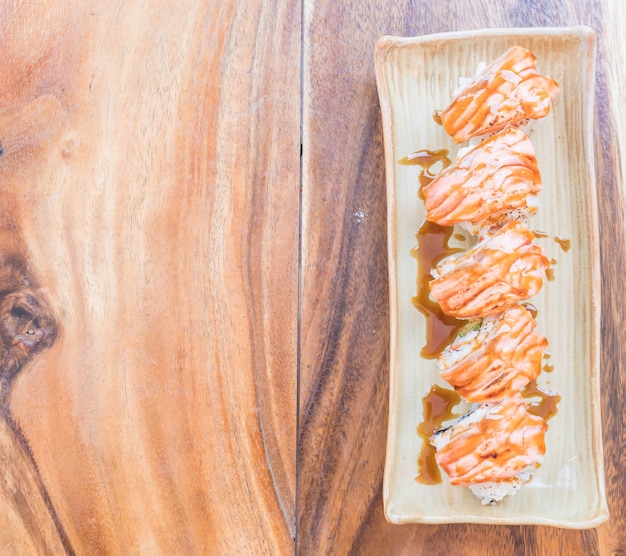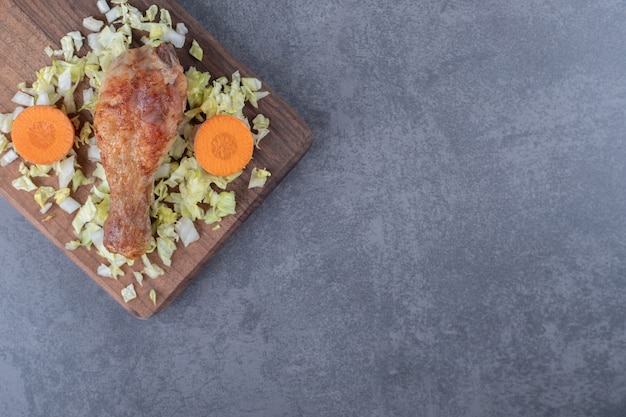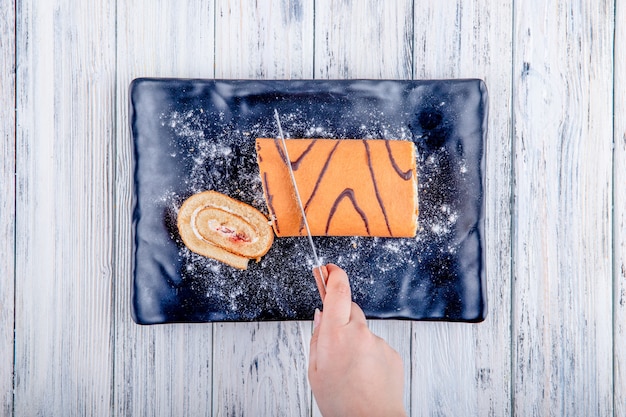Let's face it, sometimes the last thing you want to do after a long day is spend ages in the kitchen. You just want a delicious and satisfying meal that won't leave you feeling exhausted. And that's where frozen salmon fillets come in! They're a real lifesaver when you're short on time and energy, and they can be transformed into something truly delicious.
I know what you might be thinking: "Frozen fish? Can it really be good?" Trust me, it absolutely can be! In fact, I use frozen salmon all the time and it's always a hit with my family. They're a versatile ingredient that can be cooked in so many different ways. And the best part? They're so easy to work with!
So, grab your favourite seasonings, roll up your sleeves, and let's embark on this culinary adventure together! This step-by-step guide will walk you through everything you need to know to turn those humble frozen salmon fillets into a delicious and satisfying dinner.
(Part 1) choosing the right salmon

The first step is choosing the right salmon. Now, I personally prefer wild-caught salmon for its rich flavour, but it can be a bit pricey. Don't worry if you're on a budget, farm-raised salmon is a perfectly good alternative! The important thing is to look for fillets that are firm, have a bright pink colour, and don't have any fishy or off-putting smells. Avoid any fillets that look dry, have a slimy texture, or are discoloured.
Understanding Frozen Salmon Labels
You'll often see frozen salmon labelled as "fresh-frozen." This simply means the salmon was flash-frozen right after being caught, so you're still getting the freshest possible salmon. However, try to avoid fillets that have been frozen for too long, as the quality can deteriorate. Look for packages with a recent "best before" date to ensure freshness.
(Part 2) Prepping the Frozen Salmon

Alright, now for the prepping! The key here is not to thaw the fillets completely. We're aiming for "partially thawed," which will help the fillets cook evenly and retain their moisture.
Step-by-Step Guide to Thaw and Prep
- Transfer to the Fridge: Take your pack of frozen salmon fillets out of the freezer and place them in your refrigerator. Let them thaw for a couple of hours, or even overnight. This slow thaw will ensure they don't become watery.
- Check for Thawing: After a few hours, check the fillets. They should be beginning to soften but still firm to the touch. That's the perfect stage to start prepping.
- Pat Them Dry: Carefully remove the fillets from the fridge and place them on a plate or your chopping board. Pat them dry with kitchen paper. This will help them to brown nicely in the pan.
- Get Seasoning: Grab your favourite seasonings. I'm a big fan of a simple mix of salt, pepper, and a little bit of paprika. But don't be afraid to experiment! You can add lemon zest, garlic powder, a pinch of chili flakes, or any other herbs and spices you enjoy.
- Season Liberally: Generously season both sides of each fillet, ensuring every bit is coated. The key is to let the flavours infuse the salmon.
- Let Them Rest: Once seasoned, let the fillets rest on the side for about 10-15 minutes. This allows the flavours to penetrate the fish and create a truly mouthwatering dish.
(Part 3) Cooking the Frozen Salmon

Now, for the fun part! Cooking your frozen salmon fillets! You have so many options: pan-frying, baking, grilling, or even air-frying. Today, we'll focus on the classic pan-frying method. It's simple, quick, and delivers beautifully crispy and flavorful salmon.
Step-by-Step Guide to Pan-frying
- Heat the Pan: Grab a non-stick skillet or pan. Place it over medium heat and let it heat up properly.
- Add Fat: Add a little bit of your favourite cooking oil. I typically use olive oil, but any heat-resistant oil will work.
- Time to Sizzle: Once the oil is shimmering, carefully place the seasoned salmon fillets in the pan. You'll hear that satisfying sizzle as the salmon hits the hot oil.
- Don't Overcook: Cook each side for about 3-4 minutes. You'll know it's done when the salmon flakes easily with a fork and has a lovely golden-brown colour.
- Rest and Serve: Remove the cooked salmon from the pan and place it on a plate. Let it rest for a few minutes before serving. This allows the juices to redistribute, making the salmon even more moist and tender.
(Part 4) Serving Your delicious salmon
Congratulations, you've cooked your frozen salmon fillets! Now it's time to serve it up. The possibilities are endless. I like to serve mine with roasted vegetables, a crisp green salad, or creamy mashed potatoes. You could also go for a lighter option with quinoa and a colourful veggie medley.
Creating a Salmon Feast
Here are some delicious serving ideas to inspire you:
- Roasted Vegetables: sweet potatoes, broccoli, carrots, asparagus, or Brussels sprouts all pair wonderfully with salmon. Toss them in olive oil, herbs, and spices, and roast until tender and slightly caramelized.
- Green Salad: Fresh lettuce, tomatoes, cucumber, and a tangy dressing make a refreshing accompaniment.
- Mashed Potatoes: Creamy, fluffy mashed potatoes are a classic comfort food that goes well with salmon. Add a little butter, milk, and herbs for extra flavour.
- Quinoa and Veggies: A bowl of quinoa cooked with vegetable broth and topped with roasted vegetables creates a light and healthy meal.
(Part 5) Adding Extra Flavour to Your Salmon
You've mastered the basics of cooking frozen salmon, but what if you want to take things to the next level?
Elevate Your Salmon Game
Here are some simple tricks to transform your salmon from "good" to "amazing":
- Glaze It Up: A glaze can add a burst of flavour and create a beautiful, glossy finish. Try a honey-soy glaze, a lemon-herb glaze, or even a spicy sriracha glaze.
- Saucy Surprise: A creamy sauce adds richness and indulgence. Consider a lemon butter sauce, dill sauce, or a simple hollandaise sauce.
- Spice Things Up: Don't be afraid to add some heat! A sprinkle of chili flakes, a dollop of sriracha, or a squeeze of hot sauce can give your salmon a delicious kick.
- Citrus Zest: A little bit of lemon zest or orange zest can brighten up the flavour and add a refreshing citrusy touch.
- Herbs Galore: Fresh herbs like dill, parsley, chives, and tarragon are the perfect way to add a touch of freshness and aroma.
(Part 6) Exploring Different Cooking Methods
We've covered pan-frying, which is great for busy weeknights. But there are other ways to cook frozen salmon. Let's explore some different culinary horizons.
Beyond the Frying Pan: Exploring Different Cooking Methods
- Baking: Place your seasoned fillets on a baking sheet lined with parchment paper. Bake in a preheated oven at 400 degrees F (200 degrees C) for about 12-15 minutes, or until cooked through.
- Grilling: Preheat your grill to medium heat. Place your seasoned fillets on the grill and cook for about 4-5 minutes per side, or until cooked through.
- Air-frying: This is a great option for crispy salmon. Place your seasoned fillets in the air fryer basket and cook at 400 degrees F (200 degrees C) for about 8-10 minutes, or until cooked through.
(Part 7) Storing Your leftover salmon
You've cooked up a delicious batch of salmon, but what about those leftovers? Don't throw them away! Frozen salmon can be easily stored and used again later.
Storing Your Salmon for Later
- Cool it Down: Let your cooked salmon cool completely. This prevents it from becoming soggy when you store it.
- Choose Your Container: Store your salmon in an airtight container or a resealable freezer bag.
- Freezer Time: Place your stored salmon in the freezer. It should last for about 2-3 months.
- Reheating: When you're ready to enjoy your leftover salmon, reheat it in the oven, microwave, or even in a pan on the stovetop.
(Part 8) The Art of Flavour Combinations
Now, let's talk about the magic of flavour combinations. This is where you can really unleash your creativity! Think of your frozen salmon as a blank canvas that can be transformed with a burst of different flavours.
Flavour Combinations: A Culinary Symphony
Here are some delicious flavour combinations to inspire your inner chef:
| Salmon | Flavour Combination | Additional Notes |
|---|---|---|
| Pan-fried | Lemon-herb glaze, roasted asparagus, and a squeeze of lemon juice | Use fresh herbs like dill, parsley, or chives for the glaze. |
| Baked | Honey-soy glaze, steamed broccoli, and a sprinkle of sesame seeds | For a touch of heat, add a pinch of red pepper flakes to the glaze. |
| Grilled | Spicy sriracha glaze, grilled pineapple, and a side of brown rice | Use a good quality sriracha sauce for a balanced sweetness and heat. |
| Air-fried | Dill sauce, roasted bell peppers, and a dollop of sour cream | Make the dill sauce with fresh dill, lemon juice, and a touch of sour cream. |
FAQs
I know you're probably bursting with questions about cooking frozen salmon. So, let's address some of the most common ones:
- Can I eat frozen salmon raw? Absolutely not! Frozen salmon should always be cooked thoroughly to kill any harmful bacteria.
- How can I tell if my frozen salmon is still good? If the salmon has a strong, fishy smell, is slimy, or has a discoloured texture, it's best to discard it.
- Can I freeze cooked salmon? Yes, you can! Just let it cool completely and store it in an airtight container or freezer bag. It will last for about 2-3 months in the freezer.
- What are some healthy ways to cook frozen salmon? Baking, grilling, and air-frying are all great healthy ways to cook frozen salmon. You can also try poaching it in broth or steaming it.
- What are some tips for cooking frozen salmon perfectly? Don't overcook it! Salmon cooks quickly, so it's easy to overcook it. Make sure it flakes easily with a fork and has a nice golden-brown colour.
There you have it! A comprehensive guide to cooking delicious and easy frozen salmon fillets. With these tips and tricks, you'll be transforming those frozen slabs into a culinary masterpiece in no time. So, grab your favourite seasonings, fire up your pan, and get ready to impress your taste buds. Happy cooking!
Everyone is watching

Prime Rib Roast Cooking Time Chart: Per Pound Guide
Cooking TipsPrime rib roast. Just the name conjures images of lavish dinners, crackling fires, and hearty laughter. It’s ...

How Long to Bake Potatoes in the Oven (Perfect Every Time)
Cooking TipsBaked potatoes are a staple in my kitchen. They're incredibly versatile, delicious, and surprisingly easy to m...

Perfect Rice Every Time: The Ultimate Guide to Cooking Rice
Cooking TipsAs a self-proclaimed foodie, I've always been a bit obsessed with rice. It's the foundation of countless cuisi...

The Ultimate Guide to Cooking Asparagus: Tips, Techniques, and Recipes
Cooking TipsAsparagus. The mere mention of this spring delicacy conjures up images of vibrant green spears, crisp and burs...

Ultimate Guide to Cooking the Perfect Thanksgiving Turkey
Cooking TipsThanksgiving. Just the word conjures up images of overflowing tables laden with delicious food, the scent of r...
